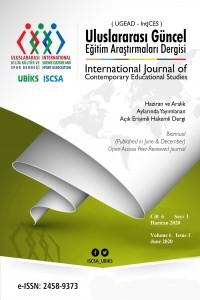Physical Education through English Teaching Experience
The implementation of a multilingual program which
contains the teaching of a subject through English in addition to the subject
of English language in our region is a reality that is slowly arriving to more
and more schools. Since the management team accepts this new educational
challenge until the chosen subject begins to work as it should, it is a process
in which the teacher has a leading role. In the following article we will focus
on the most important points that have to be taken into account by physical
education teachers in order to achieve a good implementation of this subject
through English.
Anahtar Kelimeler:
Secondary school, physical education, plurilingualism program, Spain
Physical Education through English Teaching Experience
The implementation of a multilingual program which
contains the teaching of a subject through English in addition to the subject
of English language in our region is a reality that is slowly arriving to more
and more schools. Since the management team accepts this new educational
challenge until the chosen subject begins to work as it should, it is a process
in which the teacher has a leading role. In the following article we will focus
on the most important points that have to be taken into account by physical
education teachers in order to achieve a good implementation of this subject
through English.
Keywords:
Secondary school, physical education, plurilingualism program, Spain,
___
- Adler, S., Farrar, C., King, D. (1983). A curriculum guide for developing communication skills in the preschool child. Springfield, IL: Charles C Thomas.
- Asher, J. J. (2009). Language Learning through Action, USA.
- Bailey, R. (2006). Physical education and sport in schools: A review of benefits and outcomes. Journal of School health, 76(8), 397-401.
- Bailey, R., Armour, K., Kirk, D., Jess, M., Pickup, I., Sandford, R., Education, B. P. (2009). The educational benefits claimed for physical education and school sport: an academic review. Research papers in education,24 (1), 1-27.
- Caplan,F., Caplan,T. (1973). The power of play. Garden City, NY: Anchor Press,
- Decret 127 (2012). Diari oficial de la Comunitat Valenciana. Valencia. 30 August 2012.
- De Bono, E. (1989). Six thinking hats. London: Penguin.
- ENGSO (1998). Guidelines for children and youth sport. German Sports Federation, Frankfurt.
- EUPEA (2002). EUPEA Code of ethics and good practices. Guide for Physical Education. European Council, 2001. Common European Framework of Reference for Languages: learning, teaching, assessment. Cambridge, Cambridge University Press.
- Hardman, K., Marshall, J. (2000) ‘The State and Status of Physical Education in Schools in International Context’, European Physical Education Review 6: 203–229
- Hildebrand, V. (1991). Introduction to early childhood education (5th ed.). New York: Macmillan.
- Kaczmarak, L.A. (1985). Integrating language/communication activities into the total preschool curriculum. Teaching Exceptional Children, 17(3), 183-1 89.
- LePage, P., Mills, J. (1990). The effect of a picture symbol prereading program on preschool children's attitudes toward reading. Child Study Journal.
- Moliterni, P. (2013). Didattica e Scienze Motorie. Tra mediatori e integrazione. ROMA: Armando Editore.
- Moreno Murcia, J.A., Hellín Gómez, P. (2002). Alumnos con deficiencia psíquica. ¿Es importante la Educación Física? Su valoración según la edad del alumno y el tipo de centro. Revista Internacional de Medicina y Ciencias de la Actividad Física y el Deporte, vol. 2 (8) pp. 298-319
- Morrison, G.S. (1988). Education and development of infants, toddlers, and preschoolers. Glenview, IL: Scott, Foresman.
- Peters, R. S. (1966) Ethics in education. London: Allen & Unwin Ltd.
- Ràcz, B. (2015). Il movimento e il gioco nell’apprendimento/insegnamento delle lingue straniere in educazione inclusiva (doctoral thesis). Università di Roma, Foro Italico.
- H. Ytreberg. 1990. Teaching English to children. London: Longman
- Shin, J. K. (2006). Ten helpful ideas for teaching English to young learners. In English Teaching
- Spectator (1975). You have been warned, British Journal of Physical Education, 6(6). Forum (Vol. 44, No. 2, pp. 2-13). Staiano, A. E., Calvert, S. L. 2011. Exergames for physical education courses: Physical, social, and cognitive benefits. Child development perspectives, 5(2), 93-98.
- Yin, R. (1994). Case study research: Design and methods. Beverly Hills. Scott, W., L.
- Başlangıç: 2015
- Yayıncı: Uluslararası Bilim Kültür ve Spor Derneği (UBİKS)
Sayıdaki Diğer Makaleler
Dünyada ve Türkiye’de Erken Çocukluk Dönemine Yönelik Oyuncak Kütüphaneleri Çalışmaları
İlköğretim Öğretmenlerinin Teknoloji Kullanım Yeterliliği
Mehmet KUMARTAŞLI, Şengül BÜYÜKBOYACI, Leyla KODAMAN
Aile İçi Şiddetin Bir Türü: Kardeş İstismarı
Physical Education through English Teaching Experience
Pau ESPİNOSA, Juan ESPİNOSA, Angel ESPİNOSA, Evaristo PEREZ
Gençlik Kamplarında Görev Yapan Liderlerin İletişim Becerilerinin Değerlendirilmesi
